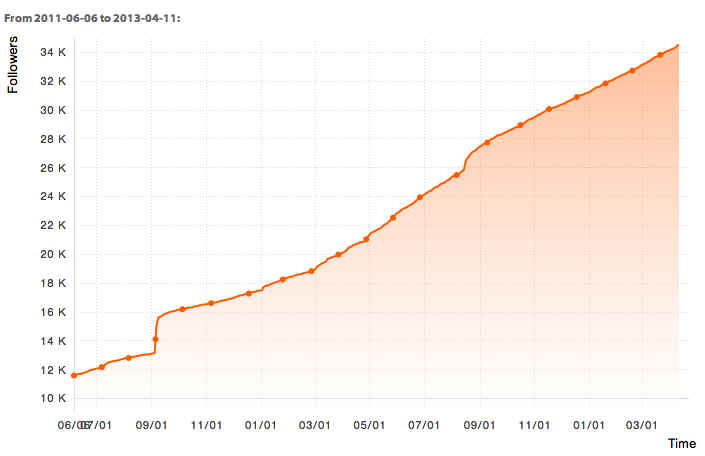
Above: My twitter followers graph for the last 2 years – it slowly grows, mostly from cross-sell from my blog to Twitter. People find it via SEO, then click the Follow button
Cold start sucks
Everyone who has tried to start a blog knows that the cold start problem is no fun. I spent about a year writing to an audience of about 10 people, including my sister and a few coworkers and friends. I inherently enjoy writing, so that was fine by me, but this phase often discourages people to write at all.
I’ve been writing this blog since 2007 and over time, have tried lots of little experiments on trying to grow the audience. I’ve built a modest sized audience with 50k+ followers/subscribers across RSS, email subscribers, and Twitter. Over the last year, I’ve stuck with one basic formula which has helped a lot, and I want to share it with you- here’s the components:
- Evergreen content
- Social whales
- Don’t get bored
Let’s talk about each one.
Evergreen content follows a Power Law curve
First off, it starts with the content. Just like anything else, there’s a Power Law curve, and a small number of my posts end up generating a very long tail of traffic over months and years. These are my “evergreen” pieces of content which creates a solid base of traffic for the blog even when I’m not particularly active with my blog. They often have a spreadsheet or presentation or some other kind of “asset” that makes it a useful post. Or it’ll define a commonly used piece of jargon that gets Googled, often as “how do I calculate X” for instance. Another strategy is to try a small tweet, and if if people seem to like it, I’ll turn it into a blog post (full discussion on that strategy here). And it may surprise you to know that the title of the blog post matters as much as the actual content of the post. That’s why the tweet-the-title-then-write-it strategy works so well.
The above strategy works because if you can only write every once in a while, you’re probably not going to be breaking news like the pro journalists. So instead you’ll have to differentiate on expertise and insight, rather than trying to tag along on whatever cool topic we are talking about these days. Drones. Bitcoin. Snapchat. Google Glass.
Viral spread of content on social platforms also follows a Power Law curve
The second thing, kind of obvious, is to share your content out to the various platforms after you write it. The less obvious thing is that you are better off “betting the farm” on one platform – say Twitter or Facebook or Linkedin – rather than trying to include links for all 3 and more. I focus on Twitter, and put a big follow button on the bottom of every one of my posts. Focus really helps because first off, the Power Law will show up again and you’ll find all your traffic comes from 1-2 sources anyway. And if you build up an audience and a consistent set of tools and techniques to spread your content on that platform, you’re better off.
Furthermore, even from an individual source of traffic, the distribution of followers on these social platforms also follows Power Law. Thus, it’s really important to have the “social whales” publish your content to their audience- that matters a lot. For me, the difference between a successful post (hitting 10,000s of people) or an unsuccessful one is often a few retweets from folks like Eric Ries, Hiten Shah, Dan Martell, and others. And often these kind of digital relationships are really built on real-life relationships, which is kind of ironic. As much as the world has become global, it’s still important to build real, authentic relationships with people in your field, and that can help with how many Twitter RTs you get.
And finally, don’t get bored
The hardest thing about maintaining a blog is that it’s hard to have something interesting to say every day. It takes years to build up a base of content, get inbound links for SEO, and create real-life relationships with folks in your industry. So rather than optimizing for posts that get traffic, ultimately I think you have to pick topics that you want to write about on a weekly basis and keep going.
How it all fits together
OK, so here’s the summary, in even more colloquial terms:
- Write evergreen content that people want to read now, but possibly a year from now (breaking “news” sucks, leave that for the pros)
- Push all of your content onto social platforms, and get people to retweet it
- This generates SEO, which brings in more people, which brings in more followers
- Rinse and repeat, and don’t get bored
Ultimately, there’s a loop in there that drives the accumulation of traffic, but the cornerstone to all of this is content that people want to read.